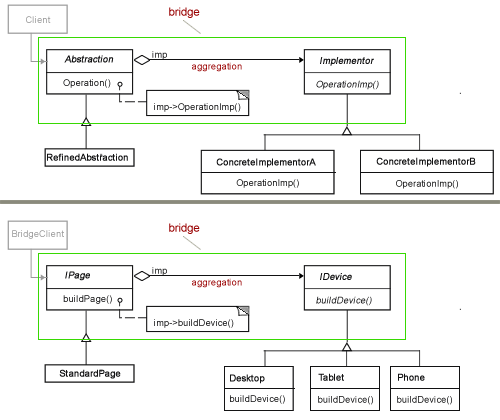 Two Interfaces
Two Interfaces
The intent of the Bridge pattern is to decouple an abstraction from its implementation so that the two can vary independently. (GoF 151) If you don’t think about that much, it sounds like a good idea to keep an application from grinding its gears when a change is made in either the abstraction or implementation. The Freemans (Head First Design Patterns, pp. 612-613) have a great example—a universal remote control. The remote control is the abstraction and a TV set is the implementor. Concrete implementors are the different brands of TVs. As new technology arises, the remote control can be updated with new gizmos. Likewise, the TV sets can also be updated and different brands will have their own unique features. A good Bridge design will allow each to be changed without breaking the other. So far so good.
An Abstraction Has-A Implementor
About six years ago, I started looking at different Bridge design pattern examples. I ran into examples that were examples of something but did not seem to be Bridge patterns. (One was nothing more than a single interface with two different implementations. The coder explained, See, that’s a bridge. I sat there with question marks floating above my head like some cartoon character.) The GoF intent statement and Freeman example were quite clear. However, the Abstraction interface and the Implementor interface, either of which could be an abstract class or interface structure, were bridged by the abstraction having-a implementor. To fully understand a Bridge pattern, you need to understand the relationship known as a bridge between the Abstraction and Implementor participants. First, though, see what the results are by pressing the Play button and Download the files:
![]()
![]()
For an overview, take a look at Figure 1. The top half is the structure laid out by The Gang of Four—the generic class diagram for a Bridge pattern. The bottom half is the PHP implementation that addresses a common issue: Variation in the content of a Web page and the structure of a Web page. By having two interfaces, either can change independently of the other. The example shows a Web page with variable content that is displayed in desktop and mobile devices.

Figure 1: Bridge Class diagrams
One of the important features of the Bridge pattern turns out to be quite subtle and easily overlooked.
The key method (Operation()) in the Abstraction participant is a concrete one.
In the example for this post, the IPage abstract class includes the buildPage() method. The buildPage() method uses a concrete implementation of the Implementor participant, (IDevice). You can see how the method is implemented in the IPage abstract class:
< ?php abstract class IPage { //Low-level abstract function doDevice(IDevice $deviceNow); //High-level protected function buildPage() { echo $this->deviceSelected->buildDevice($this->header,$this->graphic,$this->body); } //Properties protected $header, $graphic, $body, $deviceSelected; } ?> |
As you can see, the abstract function doDevice() expects an IDevice object as a parameter. The $deviceSelected property is one that will be assigned a concrete Implementor (IDevice). So, in the sense that both an abstract reference using code hinting and a concrete use of an implemented IDevice are part of the IPage abstract class, it can be said to “have a” Implementor (IDevice). (Click below to see the rest of the Bridge pattern.)
Continue reading ‘PHP Bridge Design Pattern’
Recent Comments